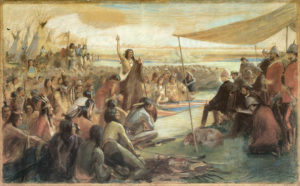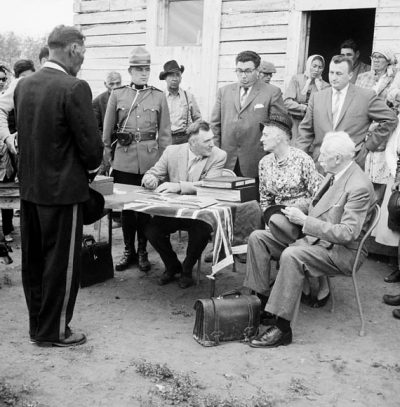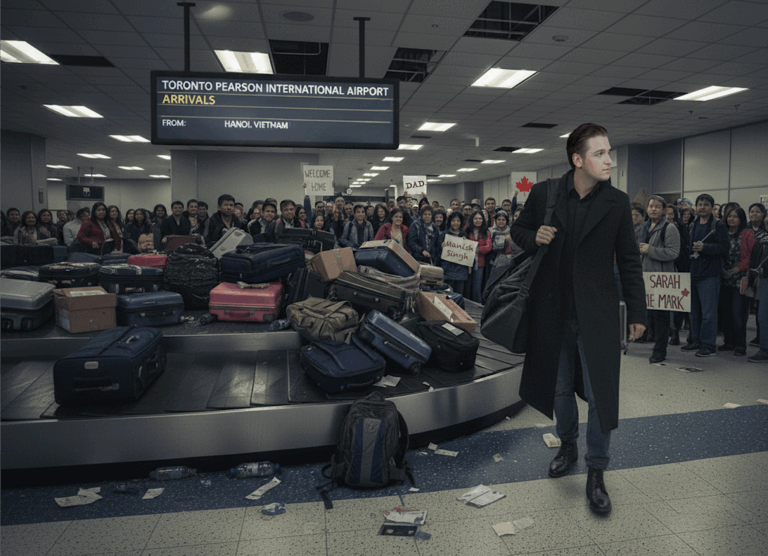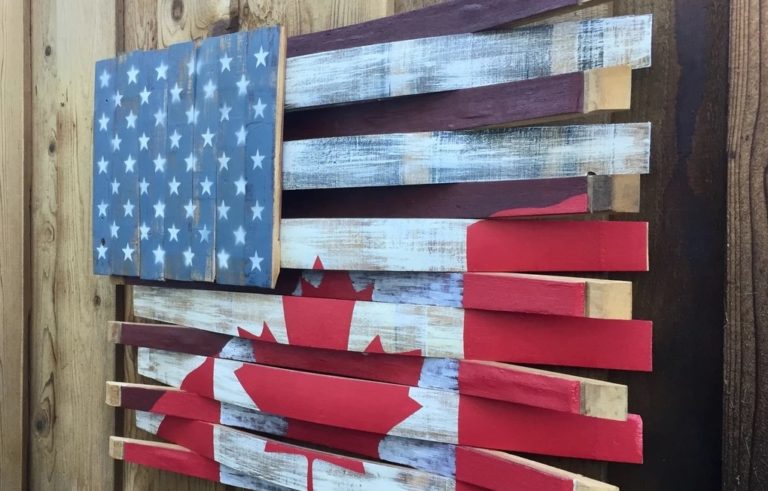As the final leg of the world-famous Bruce Trail – the country’s longest and oldest hiking trail – Ontario’s rugged Bruce Peninsula places a physical exclamation mark upon some of Canada’s most spectacular and well-loved scenery. Separating Lake Huron from Georgian Bay and featuring many kilometres of dramatic limestone cliffs, the peninsula is home to two national parks – including a marine park renowned for its diving – as well as family-friendly sand beaches and countless cottages. It’s a national treasure enriching all Canadians. But for how long?
An audacious Indigenous court case recently begun in a Toronto courtroom seeks control over the entire Bruce Peninsula, plus all the water surrounding it. The culmination of novel legal action begun two decades ago, Saugeen Ojibway Nation v. Canada demands the surrender of all Crown land in the area, including both national parks as well as road and shore allowances held by federal, provincial and municipal governments. It also wants to establish Aboriginal title over the water and lakebeds of Lake Huron and Georgian Bay.
The implications of all this are dramatic. This is the first time a native land claim has sought title to “water territory.” And the transfer of publicly-held shore allowances to native hands could also mean a crippling loss of water access for cottagers and public beach users alike. In addition to a unique and expansive bid for public land and water, the suit also seeks assorted compensation from taxpayers that could run as high as $90 billion: $80 billion in restitution plus $10 billion in punitive damages. It’s a staggering amount nearly equal to Ontario’s entire annual tax revenue.
As difficult as it may be to conceive, however, the prospect of handing over a massive swath of popular public lands along with a fabulous sum of money to a local Indigenous population of approximately 1,500 is not the greatest threat this case poses to Canada. At the risk of running out of superlatives, this particular land claim threatens far greater damage by striking at the very foundation of the Canadian system of private property ownership.
While the claimants say they have no designs on privately-held land such as cottages, homes or businesses on the Bruce Peninsula − that their objective is only to seize Crown land and grab hold of the public purse − no one should find any comfort in such statements. This case, with all its unusual legal stratagems and mind-boggling financial implications, is properly viewed as the latest example of a decades-long campaign of inventive Indigenous legal doctrine that has as its end goal the possible extinguishment of the entire concept of fee simple land ownership throughout Canada.
Further, this quiet but potentially earth-shaking undoing of our country’s legal foundations is being enabled and facilitated by deliberate federal government policy. The most recent example is former federal Justice Minister Jody Wilson-Raybould’s once-secret, now-explicit plan to stack the deck against Ottawa in any legal confrontations with Indigenous groups. Other aspects include the whole-hearted acceptance of expansive new interpretations of native rights and federal obligations, a de facto veto over new resource development projects, costless legal challenges and, perhaps most significant of all, the federal government’s apparent acquiescence to the legally-toxic doctrine of “sharing the land” that seeks to rewrite every treaty ever signed between the Canadian government and Indigenous peoples.

Canadians, in other words, can no longer rely on common sense, judicial precedent or historical facts to protect their far-reaching interests in the concept of private property in this country. As large as $90 billion or the loss of much-visited public land on the peninsula may seem, the real stakes in the Battle for the Bruce may be far greater still.
Ottawa’s “heads you win, tails I lose” legal strategy
This past January, as Wilson-Raybould was realizing her time as Minister of Justice and Attorney-General was quickly coming to an end given her impasse with the prime minister over the SNC-Lavalin affair, she put a few unusual things on her to-do list. One was to secretly record her phone conversations. Another was to formalize a little-noticed bit of government legal business called the Attorney General of Canada’s Directive on Civil Litigation Involving Indigenous Peoples, widely known as the Practice Directive.
The Practice Directive is a set of instructions to guide federal lawyers engaged in legal matters with Indigenous groups. Significantly, these marching orders have been crafted to give Indigenous claimants the whip hand every time they meet Ottawa in court. Federal lawyers are instructed, for example, to make all possible efforts to bring about a result that leads to “reconciliation” rather than to seek a clear victory for the government. Certain legal defences, such as adopting a literal reading of treaties and other documents, are explicitly discouraged. Federal lawyers are also instructed to be as liberal as possible in interpreting all other aspects of the law, to act quickly for the benefit of Indigenous claimants and to seek alternative resolutions, especially those that involve Indigenous traditions possibly at odds with conventional jurisprudence. The directive governs not only Wilson-Raybould’s former department but any ministry interacting with Indigenous organizations.
This is a reversal of long-held practices elsewhere in federal legal operations. In all other situations, it is the assumed responsibility of government lawyers to strongly defend the Crown’s position and vigorously pursue the best interests of the taxpayers so represented. When the government faces litigation and chooses to defend itself in court, it presumably believes its position is the right and lawful one deserving of significant resources and effort. Throwing away available facts, legal arguments, judicial precedents and accepted tactics is a waste of time and effort and threatens to impose new costs on taxpayers as well as to diminish the established rights and jurisdictions of governments, organizations, companies or private individuals acting within current law.
While Wilson-Raybould only formally issued the new policy of surrendering to Indigenous claimants in January, her Practice Directive had been secretly in effect for two years. The secret operation of an instrument of such profound change makes a mockery of the current federal government’s promise to openness and honesty.
To properly conceptualize the significance of Wilson-Raybould’s directive, consider the effect on the income tax system if Canada Revenue Agency lawyers were similarly instructed to seek reconciliation with taxpayers rather than their taxes owing. The result would be chaos. And a dramatic decline in taxes paid. But when facing Indigenous litigants, federal lawyers are now under orders to abandon their traditional role as unambiguous advocates for the Government of Canada and the interests of the nation. And even when the court gives a decision on Indigenous matters that Justice lawyers believe to be wrong in law, they’re further instructed to avoid appealing if doing so could hurt the chances of reconciliation.
Wilson-Raybould only formally issued this new policy on January 11, 2019, three days before she was shuffled out of her portfolio. The Practice Directive had, however, been in effect for two years prior to this announcement. The secret operation of an instrument of such profound change makes a mockery of the current federal government’s promise to openness and honesty. It also casts doubt on Wilson-Raybould’s now-legendary integrity: she chose to make the Practice Directive public with no external discussion and formalized it on the eve of her departure. In signing it after she knew she was leaving, she could also be accused of attempting to tie the hands of her successor – in essence what she complained others were doing to her when she denied SNC-Lavalin the Deferred Prosecution Agreement it so urgently wanted.
As discussed in a previous C2C Journal article, Wilson-Raybould’s close ties with the Assembly of First Nations (AFN) further suggests a potential conflict of interest given her duties to Canada as Minister of Justice and her responsibility to safeguard the Canadian taxpayer’s interests.
Lawyers litigating badly
Lawyers inside and out of government have begun raising alarms about the harm done by the Practice Directive. A recent report in the National Post brought to light an internal memo offering a Department of Justice (DOJ) insider’s view of this explosive issue, concerns apparently shared by other lawyers across the department. From the memo:
“Everyone would be happy to see disputes between the Crown and First Nations that are currently in litigation be settled by negotiation instead. That would seem consistent with a constructive approach to reconciliation. Generally, however, that is not happening, and DOJ’s path to reconciliation might instead be characterized as instructing its lawyers to ‘litigate badly’…This approach decreases the likelihood of Canada mounting a successful defence to litigation or even ensuring that necessary legal issues are fully canvassed in court; while this might seem like a ‘back door’ approach to amiable settlement with Indigenous plaintiffs, such an approach might be argued to be inconsistent with democratic values and public trust. It certainly seems to be inconsistent with upholding the rule of law, which is generally recognized as the fundamental responsibility of an Attorney-General.”
The memo further accuses Wilson-Raybould of creating an environment that “created dilemmas and reduced morale” by deliberately refusing to appeal lower-court Indigenous victories that Crown lawyers regarded as unfair.

Michael Wernick, the Clerk of the Privy Council – he who was on the other end of Wilson-Raybould’s surreptitiously recorded phone call – raised similar concerns during his dramatic testimony on the SNC-Lavalin affair before the Justice Committee in March. “The Committee may wish to hold hearings on the Attorney General of Canada’s Directive On Civil Litigation Involving Indigenous People issued by the former Attorney General,” Wernick warned the assembled MPs. “The Directive to all Government of Canada litigators could mark a profound change in Canada’s legal landscape…All political parties now need to be clear with Canadians on the future of this Directive.” His warning was unusually explicit and dire for a bureaucrat. And while evidence of the issue’s importance is clear, Wernick’s aloof and arrogant demeanour did him no favours. His concerns were roundly ignored by MPs focused on the blood sport of political scandal.
Lawyer and author Peter Best’s recent essay, The Trudeau Crown Sovereignty Surrender Directive, offers additional insight into how the Practice Directive could affect Indigenous claims:
“The Directive assumes that the public interest is the same as the asserted Indigenous interest in issue, and nothing else. Thus it discourages and in some cases even prohibits Canada’s lawyers from asserting procedural rights and substantive legal arguments that might conflict with the asserted Indigenous interest. It forces Canada’s lawyers to fight asserted Indigenous legal claims with one, sometimes both, hands tied behind their backs. This is shameful and disastrous to the welfare of Canada.”
Wilson-Raybould’s Practice Directive has already caused great mischief in Canada’s courts, most obviously in the Restoule case decided late last year. This case involves claims made by Ojibway First Nations about treaties they signed in 1852 for territory on the north shore of Lake Huron and Lake Superior. Despite the treaties’ explicit contract of fixed annual payments in exchange for the surrender of land to the Crown, the claimants sought to re-write this century-and-a-half-old agreement in order to receive in perpetuity a portion of all Crown income currently generated in the area once surrendered. A summary judgement found for the Ojibway, and negotiations are now ongoing over how great a share they will get. They are demanding between two-thirds and 100 percent.
According to Best’s analysis, federal lawyers acted exactly as required by the Practice Directive in Restoule and, unsurprisingly, came out on the losing end. Examples of this commitment to failure can be seen in neglecting to challenge self-serving testimony from native elders, ignoring the post-treaty conduct of Indigenous groups that suggested they accepted the treaties as written, and agreeing to a summary judgement rather than litigating aggressively. In further obeisance to Wilson-Raybould’s spell, Ottawa chose not to appeal this deeply-flawed ruling, placing its fixation with reconciliation firmly above legal coherence. (Thankfully, co-defendant Ontario under the Progressive Conservative government of Premier Doug Ford is not similarly eager to surrender and is pursuing an appeal.)
No job for judges
The Practice Directive’s spirit seems to have seeped across the courtroom floor to infect the bench as well. In Restoule, Ontario Superior Court Judge Patricia Hennessy appeared to abandon her traditional role as an impartial arbiter of justice in order to seek the pleasure of her Indigenous claimants’ company. As part of the court proceedings, the judge moved the hearing to three different native reserves, where she and the entire court party participated in community feasts, sweat lodges, eagle feather ceremonies and other events that immersed – some might say indoctrinated – them in the ways of traditional Indigenous teachings. Her judgement even expressed great gratitude for all this hospitality.
In other circumstances, this sort of behaviour would be considered an egregious and fatal error for a judge. How would it look, for example, if the judge in the upcoming SNC-Lavalin fraud case was seen to be wined and dined by the firm’s executives and directors as they instructed her in their unique corporate practices and traditions? And what if that judge explicitly thanked the firm in her judgement for being such a great host?

While it may be politically beneficial, at least in the short term, for the federal Liberals to create a system of subterfuge in which they deliberately lose every case involving native claimants in order to provide solace and success to Indigenous groups, such an approach violates the very core of our finely balanced system of justice. The courts are not supposed to act as a reconciliation device; they are designed to seek justice. Their well-worn framework, carefully nurtured over millennia, ensures each side clearly and unambiguously sets forth and argues its own position. Over this a judge presides: observing and ultimately ruling with strict neutrality on the merits of what has been put before them.
Reconciliation is not a job for judges, however much Liberal politicians might like to shift that responsibility onto them. The claimants in Restoule or the Saugeen Ojibway Nation case over the Bruce Peninsula hope to win enormous sums of money and/or land for themselves; federal lawyers should be there to present their best case on behalf of Canada and all its citizens, the majority of whom do not wish to see their interests treated in such a cavalier or sloppy manner. Simply giving-up does not facilitate reconciliation or justice. Similarly, neither objective is achieved when the judge meant to oversee such proceedings acts in a manner that raises questions of bias in an effort to reach reconciliation.
Despite the many concerns raised about Wilson-Raybould’s Practice Directive by lawyers inside and out of government, it remains in force. Considering Prime Minister Justin Trudeau’s precarious position with the Indigenous community, it seems unlikely to be withdrawn anytime soon. Yet the longer it stays, the more damage it does by undermining existing cases and encouraging the filing of new ones by native groups who’ve just seen their odds of winning grow exponentially.
No financial risk to Indigenous litigants, for Ottawa pays everything
Other new policies are contributing to this stacking of the odds. In the 2018 federal budget, Ottawa announced it will henceforth pay all legal costs incurred by Indigenous groups negotiating comprehensive claims with “non-repayable contributions”. Previously, Indigenous groups’ legal expenses were covered by federal loans to be repaid when the case was concluded. This was a reasonable system that recognized legal action is not costless and should not be engaged in frivolously.
Now, however, Indigenous groups can sue the federal government without regard to cost. The 2019 federal budget set aside a further $1.4 billion over the next seven years to forgive all currently outstanding land claim loans and to repay groups that had previously paid off older loans. According to Ryerson University’s Yellowhead Institute, there are 45,000 outstanding Indigenous land claims waiting to be adjudicated in this country. With the government ensuring future legal action is now entirely free for Indigenous claimants, the number of potential new cases should probably be considered limitless.
To the pernicious implications of the Practice Directive and cost-free legal action may be added a variety of other current government policies, behaviour and legal doctrines. These include recent judicial inventions such as the concept of the “honour of the Crown” and “duty to consult,” both of which have been used to insert new meanings into old treaty documents. In addition is the de facto veto Indigenous groups now hold over large new resource developments. Also included should be the steady stream of government announcements recognizing any and all demands made by Indigenous lobby groups, from native language rights and spurious cultural appropriation demands to changing the names of historic buildings to the endless series of government apologies and self-abasements. All of which leave Canadian taxpayers and property owners at the mercy of ever-more vexatious and potentially damaging demands made by Indigenous claimants.
The meaning of Treaty 45½
Many troubling aspects of Indigenous litigation are crystallized in the Saugeen Ojibway Nation case. With 200 court days scheduled over the next three years, the Battle for the Bruce Peninsula is predicted to be the longest trial in Ontario legal history. As with Restoule, many of the hearings will take place on reserves and in community centres, outside traditional courtrooms. This creates the risk that, like Judge Hennessy, presiding Judge Wendy Matheson will become entranced and entangled by native spirituality. Also like Restoule, the case rests on an imaginative reworking of existing treaties and new legal theories designed to stack the deck against Canadian taxpayers. But in many ways Saugeen Ojibway Nation is far more audacious even than Restoule.

First, some history. The two constituent parties of Saugeen Ojibway Nation − Saugeen First Nation and Chippewas of Nawash Unceded First Nation − each signed treaties with the Crown covering what they claimed to be their traditional territories. The first, in 1836, is the curiously numbered Treaty 45½, which transferred about 600,000 hectares of potential farmland in the area south of present-day Owen Sound to the Crown in exchange for Indigenous control over Manitoulin Island and the Bruce Peninsula, plus various government supports such as housing. Significantly, this treaty included a promise to the natives that the government of Upper Canada “engages for ever to protect for you from the encroachments of the whites.”
Eighteen years later, however, the Crown found itself powerless to stop settlers from moving into the Bruce Peninsula area. It therefore sought to rework the land arrangement by means of Treaty 72, which established specific and well-protected reserves for the Saugeen and Nawash tribes in exchange for broader white settlement of the region. Further, in recognition of the problems inherent with Treaty 45½, all proceeds from land sales in this region were to be placed in an annuity fund, with annual payments disbursed to the bands. These financial obligations are not at issue in the current claim. Rather, the Saugeen Ojibway Nation case against the federal and provincial governments, as well as four local municipalities, essentially seeks to have Treaty 72 cast aside or entirely reinterpreted.
What the Bruce lawsuit is about
Saugeen Ojibway Nation makes three specific demands. First is a unique and unprecedented claim of Aboriginal title over the “water territory” of Lake Huron and Georgian Bay, on the basis that such water rights are indivisible from the claimants’ traditional way of life and should have been included in the original treaties. Second is the handing over of land not presently privately-owned, including publicly-accessible road allowances, shorelines and parks, due to the Crown’s failure to abide by the first treaty. Third, a staggering $90 billion in compensation for land that cannot be returned, as well as lost hunting rights surrendered when the treaties were signed.
The meaning and import of Aboriginal title over navigable waters is entirely uncertain within Canadian law. Nowhere in the Saugeen Ojibway Nation statement of claim do they explain what they wish to achieve by gaining control of lakebeds or rivers, or what the implications might be for the rest of the country. Rather than a practical demand, it is probably best seen as yet another grasping attempt to widen the scope of future native land claims by asserting ownership over yet another part of Canada – the watery part.

The second and third demands are equally problematic. Many Canadians might reasonably express some sympathy for the Ojibways’ loss of the Bruce Peninsula more than a century ago due to settler encroachment; perhaps some additional compensation is even due, mainly to assuage white guilt. But taken broadly, the westward expansion of Canada and the United States ought to be considered an unstoppable force of nature. As with King Canute and the tides, the British Crown was never able to hold back European settlers moving westward in any circumstance. An attempt to set a boundary between native and white lands in Colonial America following the Seven Years’ War − using the Appalachian Mountains as the border and as described in the Royal Proclamation of 1763 − ended in abject failure and helped spark the American Revolution. The Canadian government likely came to realize it similarly lacked the ability to stem the tide heading towards the Bruce Peninsula.
Given the history of North American settlement, the Canadian government arguably did all that could reasonably be expected to enforce the first treaty. Treaty 72 should thus be seen as a well-intentioned effort to adjust to reality by creating permanent reserves and supporting them with income earned from land sales. Any claim that seeks the return of all remaining public land along with tens of billions of dollars in cash must necessarily abrogate the second treaty, which both parties signed in good faith. It is an attempt to rewrite history and tear up a legally-binding contract.

Given the Practice Directive and Ottawa’s panoply of accommodationist Indigenous policies, there is no good reason to expect vigorous defense against these new claims. Reconciliation-seeking federal government lawyers will likely cave-in at the first opportunity rather than defend the enormous private and public interests at stake, as well as the profound, age-old points of law and principle now in play. That was certainly the case in Restoule, where the judge – perhaps after having enjoyed herself at the sweat lodge or eagle feather ceremony – ignored the plain meaning of the treaties before her and instead ordered the federal and provincial governments to enter into negotiations with the Ojibway claimants, with potentially crippling financial implications.
The legally-toxic “sharing doctrine”
Restoule and Saugeen Ojibway Nation are properly seen as the latest iterations of a legally-corrosive concept that’s been growing in the background for decades. The “share the land” doctrine posits that signed documents do not mean what they actually say or were understood to mean when they were signed. Although the words on the treaties’ paper may plainly state that they are land surrender documents, they should be interpreted as mutual pledges by government and Indigenous groups to jointly “share” the land in question.
Of course this upends the entire concept of treaties, transforming them from clearly demarcated final settlements into mere opening rounds of endless negotiations, payments and concessions. For the first 100 years after the signing of the treaties, anyone who put forward such a fantastical theory would have been laughed out of court. The St. Catharines Milling case of 1887, for example, makes it crystal-clear what the treaties meant: land was being surrendered for consideration including cash, annuities and the promise of government assistance.
Many, if not most, past generations of Indigenous leaders accepted treaties as such. William Wuttunee, the first Indigenous lawyer to practise in western Canada and the founder of what is now the AFN, publicly chastised his native colleagues who pretended treaties were more than they appeared to be. Wuttunee recommended that his compatriots integrate with the rest of society and seek success by the sweat of their brow, rather than living in the past. “A great injustice is being done to Indian people if we tell them that the white man did not keep his promises under the treaties,” Wuttunee wrote in his 1971 book Ruffled Feathers. “We must therefore make every effort to re-educate all Canadians to the facts of history. The federal government has kept its promises under the treaties.”

The origin of the current “share the land” campaign is murky. The phrase began to appear in speeches and pro-Indigenous essays and books soon after the Charter of Rights and Freedoms’ promulgation in 1982. Once courts and governments began to financially reward Indigenous claim-seeking, advocates dumped Wuttunee’s emphasis on individual responsibility in order to blame governments as the source of all their woe: demanding open-ended, perpetual compensation and arguing treaties were meant as virtual pensions-for-life for every reserve resident. Indigenous firebrands like British Columbia’s Bill Wilson (Jody Wilson-Raybould’s father) and Manitoba’s Chief Louis Stevenson eagerly promoted radical ideas about land ownership in the 1980s and 1990s.
Still, the notion that treaties do not mean what they clearly say has only taken firm hold in the past decade. Today, however, Indigenous publications, Supreme Court rulings and even official government documents state or implicitly accept the sharing doctrine as fact. But what does such a thing mean for the concept of private property?
By repeatedly stating privately-held land is not covered by these latest, high-profile claims, “share the land” advocates have so far avoided alarming ordinary Canadians concerned about the fate of their own homestead. Restoule, for example, demands a share of Crown rent rather than the wholesale transfer of Crown property. Saugeen Ojibway Nation goes further in seeking the return of Crown land on the Bruce Peninsula, control over waters, plus massive amounts of compensation. But again, it stops short of demanding the surrender of private property. The transfer of public lands demanded in this case does, however, open the possibility of new and unexpected innovations in ownership rights.
All privately held property in Canada may fall under threat
If Indigenous claimants obtain road and shore allowances from the public domain, cottagers or beach users could be cut off from the water and/or forced to pay for access to these public resources as well as to their own properties (since the litigation claims control over public road allowances). This is not mere speculation. The area’s world-famous Sauble Beach is administrated by the local municipality and is free to all visitors. The beach’s southern portion, however, is owned outright by the Saugeen First Nation, which charges an admission fee of $20 per vehicle, as well as a pedestrian rate.
Such beach-access practices can be seen as a possible sign of things to come for the entire Bruce Peninsula and environs. And beyond the “mere” cottagers, the area’s farms and more isolated businesses could find themselves cut off or forced to pay fees to the new Indigenous overlords of formerly public roads. While the decades-long “share the land” campaign has sometimes been about culture, it has always been about money and control.

Several ongoing British Columbia lawsuits – notably Cowichan and Haida Nation – appear to go beyond Restoule or Saugeen Ojibway Nation in explicitly asserting claims on private property. Cowichan, for example, seeks Aboriginal title over an area that includes 200 privately-held residences along the south end of Richmond, B.C., in a section of the sprawling city that is largely agricultural and industrial. Haida Nation demands the return of the entire Haida Gwaii archipelago, which includes over 3,000 private properties valued at a reported $450 million. Claimants in both cases deny they seek to extinguish private property rights.
Both, however, claim the Crown never held true title to the land to begin with and, therefore, could not legally pass it on to subsequent private owners. In addition, the original Haida Nation statement of claim sought to quash tenures, permits and licences granted by the provincial government. (That portion of the claim was subsequently withdrawn.) Canadian jurisprudence so far offers no guidance on how to handle the incompatibility between Aboriginal title and fee simple ownership when asserted over the same plot of land. Prior to the miasma of the Practice Directive, the federal government actually asked the court to require that property owners possibly affected by the Cowichan and Haida Nation legal battles be informed of the potential danger posed to their ownership rights; the application was denied.
Taken as a continuum, these “share the land” claims constitute a dangerous game of legal brinkmanship. Each new case takes ever-greater liberties with the expanding concept of Aboriginal title, all the while stopping just short of directly imperilling private property ownership, presumably for fear of engendering a massive outcry from the rest of the Canada. But if the court grants Aboriginal title over privately-owned lands in Haida Nation or Cowichan, or delivers public lands to Indigenous ownership in a way that puts cottage owners’, farmers’ or business owners’ ability to enjoy their shoreline, drive to their properties or even use the waters surrounding the Bruce Peninsula at risk in Saugeen Ojibway Nation, another major line will have been crossed. And without any push-back from the federal government.
Eventually, non-Indigenous Canadians must surely become alive to the threat all this poses to their own backyard – perhaps when they find themselves staring at an eviction notice or a bill requiring them to pay for access to the nearest beach. And then the fireworks will begin. In a recent legal opinion on Haida Nation and Cowichan, Cassels Brock lawyers Thomas Isaac and Arend J.A. Hoekstra note that “without an evolution of the law, Aboriginal title, where claimed, will threaten the fee simple interests of individual Canadians and pose a significant threat to reconciliation.”
But until this happens, Indigenous litigants emboldened by costless legal action and a rapidly retreating federal government can be expected to mount ever-more aggressive claims against property owners across Canada. All privately-held land in this country was originally Crown property − the “root of title” is the original Crown patent of each parcel to the original, first private grantee. A flawed Crown root of title thus means a weak and uncertain title forever. And this covers the entire country. For some, this is no longer a potentially fatal bug, but a feature to be celebrated. Independent Senator Murray Sinclair promotes a similar idea that Ottawa should renounce the ancient doctrine of Terra Nullius, the legal concept upon which all rights of land ownership in Canada are founded.
“All their property titles, including all those overpriced homes in Vancouver, are now under a cloud,” writes lawyer Best in his recent book There Is No Difference. “If, because of unceded or merely ‘shared aboriginal title’ the Crown never had full, original title to the lands it granted patents for, then the whole chain of titles to those lands, down to the present owners, comes under serious question.” With the federal government having abandoned any thought of objecting to the increasingly aggressive claims from Indigenous litigants – and with judges apparently intent on adopting a similar reconciliation-first approach to their own work − there may be no-one left to defend the concept of private property on behalf of ordinary non-Indigenous Canadians in the face of increasingly aggressive claims on their property.
All of which suggests anyone who enjoys the Bruce Peninsula might be well-advised to enjoy the water and scenery while they still can. Someone else may soon be “sharing” it – which should be read to mean taking it for themselves.
Brian Giesbrecht is a retired Manitoba provincial court judge (appointed in 1976, Associate Chief Judge from 1991 and Acting Chief Judge in 1993), a Senior Fellow with the Frontier Center for Public Policy and a freelance writer contributing to various newspapers and other publications.






